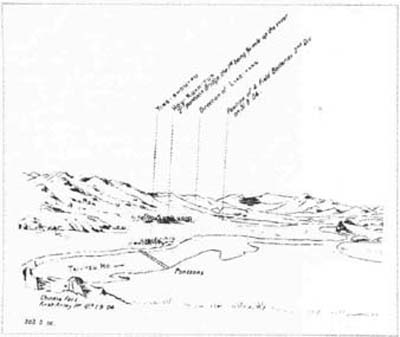
Bulletin 2 (I:2), December 1963
Home
Français
Introduction
History
Annual Index
Author &
Subject
Credits
Contact

David Milne: 1918-19
by R. F. Wodehouse, Curator of War Art
Résumé en français
Pages 1 | 2
| 3 | 4
In a recent monograph on David Milne (1) attention is drawn to
the importance which the role of war artist played in maturing his
striking individual style. Milne's war paintings, ail in dry-brush
water colour technique, reveal the aftermath of war; very seldom, if
at all, do they convey its drama or horror. The devastated
buildings, battlefields, views of military camps and towns are
depicted in an elegant, tasteful and clean manner. These paintings
represent a personal vision of things seen after the cessation of
hostilities rather than a graphic description of the path left by
war. At the outset Milne's style was rather tentative but quite
rapidly crystalized into a highly individual idiom which remained
almost unchanged long after the time he was a war artist.
Milne's movements during 1918-19, and the paintings produced during that time, are not widely known. It therefore seems fitting to note the locations visited and present a listing of the 107 works. His war paintings form part of the Canadian War Memorials Collection which is housed in the National Gallery of Canada. This collection has an interesting history. It was financed and organized by a committee, headed by Lord Beaverbrook, and its purpose was to record by means of the graphic arts the exploits of Canadians in the Great War and areas which were of historic importance. The artistic advisor was Paul Konody, a distinguished art critic and writer, who was given a relatively free hand in selecting competent artists for the task. Milne's selection as a war artist was probably made by Konody. (2)
In 1917 Milne was living at Boston Corners, Columbia County, New York, when the United States declared war. For reasons unknown, perhaps faced with the draft, perhaps unhappy with the American approach to the War, Milne decided to return to Canada and enlist in the Canadian Army. He was enrolled in the 2nd Depot Battalion, 1 Central Ontario Regiment at Toronto on 1 March 1918. (3) Legend has it that his first military duty was shovelling coal in severe weather during an emergency at the Western Hospital, Toronto. (4) The summer appears to have been spent in normal recruit training until his departure from Canada in September .
At this point Milne's documents become sketchy and confused. Although shown on strength of the 8th Reserve Infantry Battalion (which was actually at Shorncliffe, Kent) by 2 Central Ontario Regimental Depot at Witley Camp, Surrey, this appears to have been a paper transaction only. In fact, he was paid at Kinmel Park Camp, near Rhyl, North Wales on 1 October 1918 and continued to be paid there until as late as 28 January 1919. (5) At some date during this period he joined the permanent cadre of the camp. The explanation appears to be that Kinmel Park Camp was a segregation camp set up in the fall of 1918 for quarantining incoming drafts from Canada against infectious diseases, testing their standards of training, and possibly completing their knitting before moving to the training battalions in the south of England.
It was presumably while at Kinmel Park Camp that he became aware of the programme of employing artists under the direction of Paul Konody to document the war. He discovered that examples of his work were needed to show Konody before he could be employed. At his request about thirty of his paintings were forwarded from the United States, possibly by his friend James Clarke. Subsequently Milne was selected as an official War Artist. This took place after the Armistice.
There are twelve works in the collection which were painted at Kinmel Park or vicinity, with the earliest date being 14 December 1918 and the latest 1 February 1919. However, not all are dated, and it is not clear if these early paintings were done on his own or by direction, as his appointment to the Overseas Military Forces of Canada is only dated 19 February 1919. There are certain oddities of style in some of these first works which are worth noting. A few of them are reminiscent of the illustrations from the official manual of field sketching (Figs. 2 and 3). Perhaps he was not sure of what was needed and was feeling his way. On leaving Kinmel Park Camp, his individual style clearly manifests itself.
All but one of the works painted in England deal with five major camps and the countryside nearby. These are Kinmel Park Camp, near Rhyl, transformed from a segregation camp into a staging camp for returning troops embarking at Liverpool in the months after the Armistice, Bramshott and Witley in Surrey, Ripon in Yorkshire and Seaford in Sussex. These last four camps were used for concentrating soldiers returning to Canada from the Continent, remustering them into units with regional associations and then despatching them informed bodies to regional depots in Canada. Bramshott and Witley handled Canadian Corps troops, Ripon cavalry and cyclists, and Seaford engineers and machine-gunners. Of Bordon, Hampshire, not far from Witley which handled Canadian army service corps units, (6) there is only one painting.
Next Page | 1919
1 | 2
| 3 | 4
Annual Index | Author & Subject | Credits | Contact
This digital collection was produced
under contract to Canada's Digital Collections program, Industry Canada.
"Digital
Collections Program, Copyright
© National Gallery of Canada 2001"